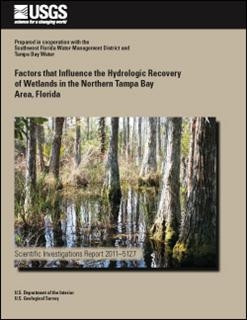
Product Details
- Product Number
- 319040
- Series
- SIR-2011-5127
- Scale
- NO SCALE
- Alternate ID
- SIR-2011-5127
- ISBN
- 978-1-4113-3231-7
- Authors
- P A METZ
- Version Date
- 11/01/2011
- Regions
- FL
- Countries
- USA
- Media
- Paper
- Format
- Bound
Additional Details
- Description
- ABSTRACT Reductions in groundwater withdrawals from Northern Tampa Bay well fields were initiated in mid-2002 to improve the hydrologic condition of wetlands in these areas by allowing surface and groundwater levels to recover to previously higher levels. Following these reductions, water levels at some long-term wetland monitoring sites have recovered, while others have not recovered as expected. To understand why water levels for some wetlands have not increased, nine wetlands with varying impacts from well field pumping were examined based on four factors known to influence the hydrologic condition of wetlands in west-central Florida. These factors are the level of the potentiometric surface of the Upper Floridan aquifer underlying the wetland, recent karst activity near and beneath the wetland, permeability of the underlying sediments, and the topographic position of the wetland in the landscape. The combination of two factors, the presence of recent karst activity below or near the wetlands and the depth to the potentiometric surface of the Upper Floridan aquifer below the wetlands, had the most influence on the hydrologic recovery of the study wetlands. The study wetlands are located in an area where numerous localized surface or buried depressions (karst features or sinkholes) are common throughout the mantled karst landscape, which increases the hydrologic connection between the wetlands and the underlying aquifers. Breaches or breaks in the underlying sediments or in the intermediate confining unit due to recent karst subsidence activity act as pathways for downward leakage. For the study wetlands, the leakage potential increased when the vertical separation between the potentiometric surface of the Upper Floridan aquifer and the wetland-bottom elevation (a surrogate for the wetland water level) increased. The increase in the potentiometric surface of the Upper Floridan aquifer below the wetland was the primary factor influencing the hydrologic recovery of the study wetlands, even in areas affected by karst subsidence. For one of the study wetlands influenced by karst subsidence (S-44 Cypress at Starkey well field), the potentiometric surface of the Upper Floridan aquifer increased to the level of the wetland-bottom elevation following the reductions in groundwater withdrawals. Despite the karst subsidence in the wetland, having the level of the potentiometric surface just below the wetland bottom limited the downward leakage potential and resulted in an increase in the flooded area and duration of the wetland hydroperiod. In contrast, two study wetlands affected by karst subsidence (W–12 Cypress and W–16 Marsh at Cypress Creek) remained mostly dry during the period of groundwater withdrawal reductions, even though the median elevation of the potentiometric surface of the Upper Floridan aquifer rose about 5 feet in this area of the well field. These wetlands are located in an area of the well field where large groundwater withdrawals are concentrated, and during the last 20 years (1989–2009) the wetlands were inundated only during periods of extreme rainfall. During these brief inundation periods, the wetland water levels receded after 1 to 2 months, much more rapidly than wetlands located in areas without karst subsidence or concentrated pumping, indicating the increased leakage between the wetlands and underlying aquifers. Because of this interconnection, water levels in these wetlands and others impacted by karst subsidence in this region will not recover if the potentiometric surface of the Upper Floridan aquifer remains at its current (2009) elevation (median distance of about 10 feet below the wetland-bottom elevation). Low permeability sediments and the absence of karst features underlying the wetlands had a positive influence on the wetland recovery following the reductions in groundwater withdrawals. In these settings, intact low permeability subsurface layers help maintain water within and beneath the wetland, and limit the downward leakage potential to the Upper Floridan aquifer. For wetlands in these settings, the increase in potentiometric surface of the Upper Floridan aquifer below the study wetland-bottom elevations resulted in an increase in the flooded area and the duration of the wetland hydroperiod. Although of less importance than the other three factors, a low-lying topographical position benefited the hydrologic condition of several of the study wetlands (S–68 Cypress and W–12 Cypress) both before and after the reductions in groundwater withdrawals. Compared to wetlands in a higher topographical position, those in a lower position had longer hydroperiods because of their greater ability to receive more runoff from higher elevation wetlands and to establish surface-water connections to other isolated wetlands and surface-water bodies through low-lying surface-water channels during wet conditions. In addition, wetlands in low-lying areas benefited from groundwater inflow when groundwater levels were higher than wetland water levels.
- Survey Date
- 2011
- Print Date
- 2011
- Height In Inches
- 11.000
- Length In Inches
- 8.500
- Two Sided
- Yes
- Pieces
- 1
- Languages
- English
Related Items



